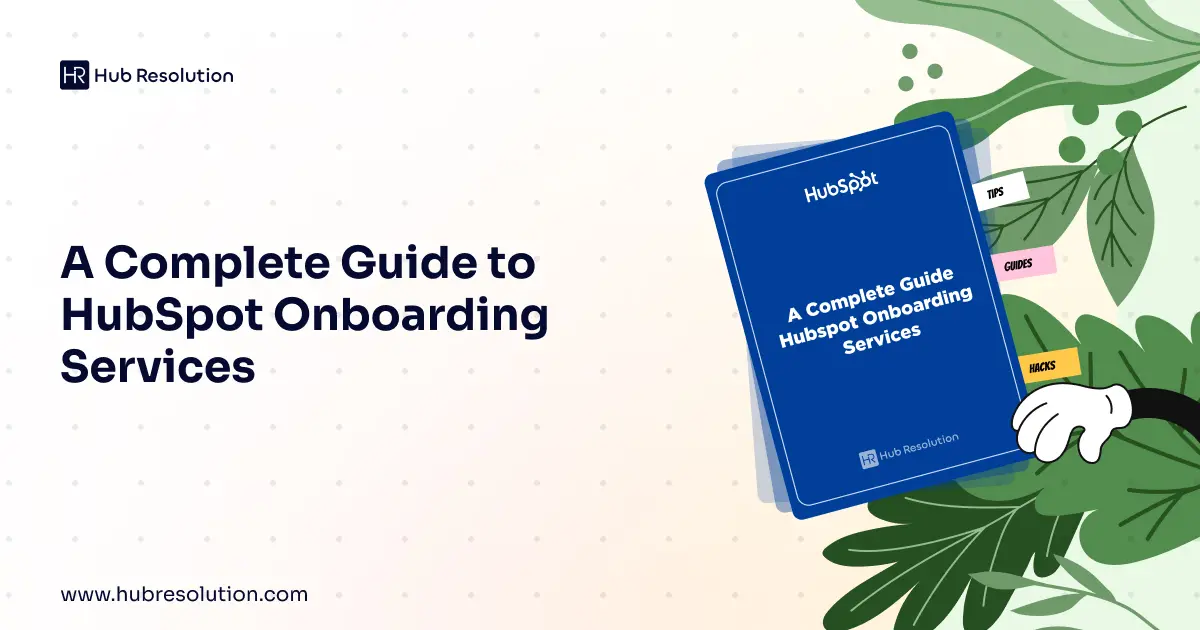Onboarding to a new Customer Relationship Management (CRM) system can be a daunting endeavor for any business, large or small. With its comprehensive suite of tools, HubSpot is a powerful platform that can transform your business’s marketing, sales, and service operations.
However, to harness its full potential, a proper onboarding process is crucial. This guide will walk you through what HubSpot onboarding entails, why it’s important, and how to ensure a smooth transition with HubSpot onboarding services.
Understanding HubSpot Onboarding
HubSpot onboarding is the process of setting up and adapting HubSpot’s software to your business’s unique needs. It is a critical phase where your team gets acquainted with the HubSpot ecosystem, learning how to utilize its features to align with your business goals.
The Importance of Effective Onboarding
Effective onboarding is essential for several reasons:
- Maximizing Return on Investment (ROI): Proper setup ensures that you are using all the features you are paying for.
- Accelerating Adoption: The sooner your team is comfortable with HubSpot Solutions, the quicker you’ll see results.
- Minimizing Disruption: A smooth transition prevents disruptions to your daily operations.
- Setting Up Best Practices: Establishing the right processes from the start can lead to long-term success.
The Onboarding Process
The HubSpot onboarding process typically involves several key steps:
1. Initial Setup and Integration
- Account Configuration: Creating user accounts, setting permissions, and defining your team’s roles within HubSpot.
- Data Migration: Transferring existing customer data into HubSpot from other CRMs or databases.
- Email Integration: Syncing your email service with HubSpot for seamless communication tracking.
- Custom Properties and Dashboards: Tailoring properties to your business and creating dashboards for quick access to key metrics.
2. Tool-Specific Setup
- Marketing Hub: Setting up marketing automation, landing pages, CTAs, and email campaigns.
- Sales Hub: Implementing deal pipelines, sales sequences, and meeting scheduling.
- Service Hub: Establishing ticketing systems, knowledge bases, and customer feedback tools.
3. Training and Empowerment
- HubSpot Academy: Encouraging your team to take advantage of HubSpot’s free online training resources.
- Custom Training Sessions: Providing tailored training sessions to address your team’s specific needs.
- Support Resources: Offering access to support documents and resources for self-help.
4. Strategy and Planning
- Goal Setting: Aligning HubSpot tools with your business goals and KPIs.
- Content Strategy: Developing a content plan that leverages HubSpot’s marketing tools.
- Sales and Marketing Alignment: Ensuring both teams are coordinated in using HubSpot’s shared tools.
Choosing the Right HubSpot Onboarding Services
While HubSpot provides comprehensive resources to aid in onboarding, the process can be overwhelming, especially for businesses with complex needs or limited time. This is where professional HubSpot onboarding services come into play. Here’s how to choose the right service provider:
- Certification and Expertise: Ensure the service provider is HubSpot-certified and has proven expertise.
- Customization: Look for providers that offer tailored onboarding plans based on your specific requirements.
- Support: Confirm that they offer ongoing support beyond the initial onboarding phase.
- Track Record: Check references and testimonials from previous clients to gauge their success.
The Role of HubSpot Onboarding Services
A HubSpot onboarding service provider will guide you through the entire onboarding process, offering support in areas such as:
- Technical Implementation: Assisting with the technical setup and ensuring all systems are properly integrated.
- Process Optimization: Helping you to map out and optimize your marketing, sales, and service processes.
- Data and Reporting: Setting up reporting tools and dashboards to track performance against your business goals.
- Continuous Learning and Adaptation: Providing resources for ongoing learning and adapting strategies based on performance data.
Best Practices for HubSpot Onboarding
To make the most out of your HubSpot onboarding experience, consider the following best practices:
- Engage Your Team Early: Involve your team in the onboarding process from the start to encourage buy-in and ownership.
- Set Clear Expectations: Define clear objectives and timelines for each stage of the onboarding process.
- Establish Governance: Create governance policies for data quality, usage, and security.
- Iterate and Improve: Use the initial onboarding period to test and refine your processes.
Conclusion
HubSpot onboarding is a critical investment in the future of your business. By properly setting up and adopting HubSpot’s powerful tools, your team can focus on what they do best—growing your business.
Whether you choose to go it alone with HubSpot’s resources or engage a professional onboarding service, the goal is to ensure a seamless transition that sets you up for success. With the right approach, onboarding becomes not just a process, but a strategic advantage in your business’s journey.

